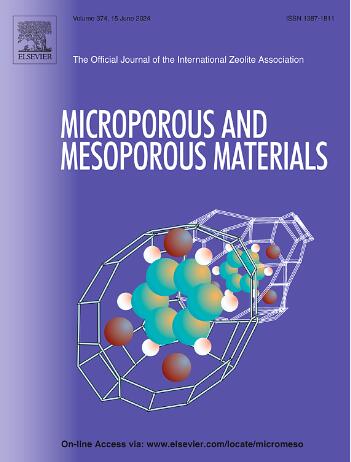Impact of anionic species on the crystallization and aluminum localization in the zeolite framework
IF 4.8
3区 材料科学
Q1 CHEMISTRY, APPLIED
引用次数: 0
Abstract
The distribution of acid sites, which are derived from tetrahedrally coordinated aluminum (Al) atoms within zeolite framework plays a critical role in the acidic catalyzed reactions, is strongly influenced by electrostatic interactions between cationic structure-directing agents (SDAs) and anionic charges. Herein, we synthesized various ZSM-5 zeolites without OSDAs and conducted an in-situ analysis to investigate the impact of anionic species from various Al sources on the crystallization and acid site localization in the framework. The results demonstrated that when Al(NO3)3 is used as the Al source (denoted as Z5-N), the electronic environment influenced by NO3⁻ alters the framework formation pathway, leading to the creation of distorted, tetracoordinated Al intermediates. This process enhances Al atoms incorporation during the early stages of crystallization, resulting in partially bonded framework Al due to lower polarization ability on Na+. In contrast, using Al(OH)₃ as the Al source (denoted as Z5-H) accelerates the nucleation process and leads to the formation of smaller particle size. Notably, the 2⁷Al multiple quantum magic angle spinning nuclear magnetic resonance (MQMAS NMR) results revealed that pure OH⁻ ions facilitate the preferential localization of Al atoms at T11 sites within the ZSM-5 framework, where the acid strength is reduced due to the larger Si-O-Al bond angle. The unique Al distributions are attributed to the strong polarization ability induced by the electrostatic attraction of OH⁻ ions to Na⁺. This study enhances our understanding of how different anionic environments influence Al placement, enabling more targeted design and synthesis of zeolite materials with tailored catalytic properties.

求助全文
约1分钟内获得全文
求助全文
来源期刊

Microporous and Mesoporous Materials
化学-材料科学:综合
CiteScore
10.70
自引率
5.80%
发文量
649
审稿时长
26 days
期刊介绍:
Microporous and Mesoporous Materials covers novel and significant aspects of porous solids classified as either microporous (pore size up to 2 nm) or mesoporous (pore size 2 to 50 nm). The porosity should have a specific impact on the material properties or application. Typical examples are zeolites and zeolite-like materials, pillared materials, clathrasils and clathrates, carbon molecular sieves, ordered mesoporous materials, organic/inorganic porous hybrid materials, or porous metal oxides. Both natural and synthetic porous materials are within the scope of the journal.
Topics which are particularly of interest include:
All aspects of natural microporous and mesoporous solids
The synthesis of crystalline or amorphous porous materials
The physico-chemical characterization of microporous and mesoporous solids, especially spectroscopic and microscopic
The modification of microporous and mesoporous solids, for example by ion exchange or solid-state reactions
All topics related to diffusion of mobile species in the pores of microporous and mesoporous materials
Adsorption (and other separation techniques) using microporous or mesoporous adsorbents
Catalysis by microporous and mesoporous materials
Host/guest interactions
Theoretical chemistry and modelling of host/guest interactions
All topics related to the application of microporous and mesoporous materials in industrial catalysis, separation technology, environmental protection, electrochemistry, membranes, sensors, optical devices, etc.
 求助内容:
求助内容: 应助结果提醒方式:
应助结果提醒方式:


